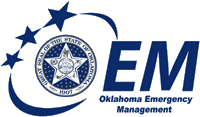- ▾ Other ShakeOuts ▾
- Alaska
- American Samoa
- Arizona
- British Columbia
- California
- Central U.S. (AL AR IA IL IN KS KY LA MO MS NE OH OK TN)
- CNMI
- Colorado
- Guam
- Hawaii
- Idaho
- Japan
- Montana
- Nevada
- New Mexico
- New Zealand
- NorthEast U.S. (CT MA ME NH NJ NY PA RI VT)
- Oregon
- Puerto Rico
- Quebec & Eastern Ontario
- SouthEast U.S. (DC DE FL GA MD NC SC VA WV)
- Texas
- Upper MidWest U.S. (MI MN ND SD WI)
- U.S. Virgin Islands
- Utah
- Washington State
- Wyoming
- Yukon
- Other Countries

Oklahoma
The Great Central U.S. ShakeOut is a multi-state drill spanning much of the central United States. This page has information for participants living in Oklahoma.
Points of Contact
Preparedness Chief/Earthquake Program Manager
Bonnie McKelvey, Oklahoma Department of
Emergency Management
Email: bonnie.mckelvey@oem.ok.gov
Phone: (405) 521-2481
Website: http://www.ok.gov/oem/
FEMA Regional Earthquake Program Manager
Bart Moore, FEMA REGION VI
Email: bart.moore@fema.dhs.gov
Phone: (940) 898-5363
PARTICIPANTS
people are currently registered to participate in this year's Great Central U.S. ShakeOut.
are from
Oklahoma
Number of Oklahoma participants in each category
View names of participants:
Oklahoma EARTHQUAKE HAZARDS
Oklahoma has historically been one of the more earthquake-prone regions east of the Rocky Mountains. Prior to 2010, Oklahoma would typically experience about 2 M 3.0+ earthquakes per year. These earthquakes would be widely felt but not cause damage. However, in 2011 a M5.7 earthquake occurred east of Oklahoma City near the community of Prague, OK. This led to moderate damage to homes and businesses in this rural community. There were dozens of aftershocks that were widely felt. Subsequent to that event, 2013 and 2014 saw a significant rise in earthquake activity towards a period when during the years 2014 and 2015, it experienced 579 and 903 M 3.0+ earthquakes, respectively.
The following links provide local and statewide earthquake hazard information:
State Emergency Management Website
https://oklahoma.gov/oem.html
State Geological Survey Website
http://www.ou.edu/ogs
USGS State Earthquake Website
https://www.usgs.gov/programs/earthquake-hazards/science/information-region-oklahoma
The scientific community broadly agrees that oil and gas activities were the cause of the widespread increase in earthquake activity. Wastewater disposal into the Arbuckle Group of rocks that directly overlie Precambrian basement rocks reactivated geologically dormant faults. The movement on the faults caused the M5.8 Prague and M5.0 Cushing earthquakes that led to moderate damage to buildings in those rural communities.
Since a peak in the activity in 2015, the seismicity rate has dropped dramatically, such that, in the year 2021 only 29 M3.0 or greater earthquakes occurred, relative to the peak of 903 in 2015. The reduction in activity rate is driven by reduced disposal volumes in the Arbuckle Group. Despite the reduction in seismicity, the seismic hazard in the state is moderately elevated and you should know what to do in the event of earthquake shaking.
The Oklahoma Geological Survey (OGS) runs the statewide network that has grown to include over 100 seismic stations and reports out the events through USGS as part of a Tier 1 regional network of the Advanced National Seismic System. Earthquake information is disseminated in real-time and OGS is available to answer public and media inquiries, as well as travel across the state for classroom demonstrations.
See below for what to do in an earthquake.
General PSA for all:
Video for Elementary Schools:
Video for Middle Schools:
Video for High Schools:
Information Source: Oklahoma Geological Survey






